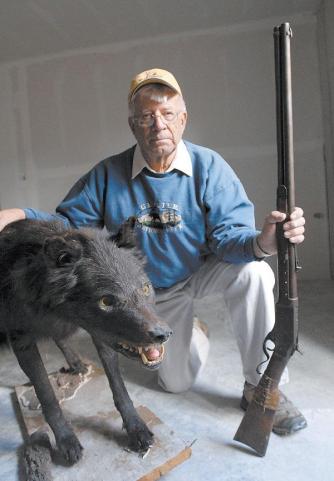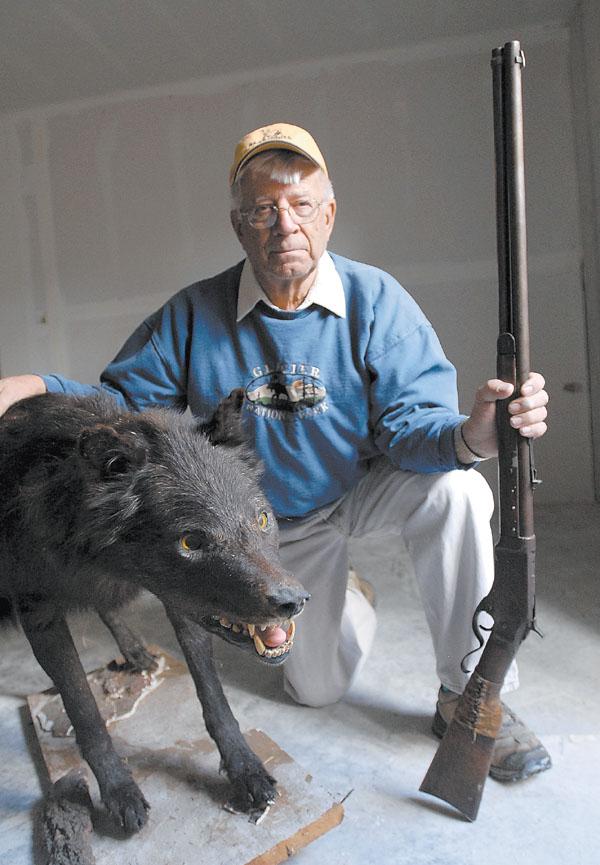
November 15, 2007

Above is the photograph which has become familiar from my book, Cryptozoology A to Z (1999), and then lifted from there to be shared throughout the internet. The story of the 19th century shooting and mounting of this unknown cryptid canine has been repeated often. It is scheduled to be one of the stories discussed in a forthcoming History Channel “Monster Quest” program. The “Monster Quest” film crew visited the International Cryptozoology Museum specifically to talk to me about this cryptid and other related canine enigmas.
The mystery of the Shunka Warak’in has been an enduring one in cryptozoology. It appears today that we may be closer to solving it. This is a remarkable turn of events, and I could not be happier to hear about this.
I look forward to thoughtful individuals considering the DNA testing of the newly re-discovered taxidermy mount. Intriguingly, if it is still owned by the the Idaho Museum of Natural History in Pocatello, perhaps now Dr. Jeff Meldrum could request the test. Dr. Irv Kornfield’s University of Maine DNA lab is ready and willing to do this testing. – Loren

Jack Kirby poses in Ennis next to the wolf-like creature his grandfather shot in 1886 in the Madison Valley. He is holding the G.W. Morse rifle that was used to kill the animal. Kirby retrieved the mount from an Idaho museum where it was being stored. Photo by Deirdre Eitel/Chronicle.
Ennis – More than a century ago, a wolf-like creature prowled the Madison Valley, killing livestock and letting out screams that one account said would leave a person’s hair standing on end.
A bullet from a Mormon settler’s rifle ended the animal’s life and triggered stories of the creature that were passed along through generations of family history and local folklore.
The only evidence of the creature’s existence was a missing taxidermy mount and a grainy black-and-white photograph of that mount – which fueled strange speculation about what kind of animal it really was.
Now after 121 years, the taxidermy mount has been found. The creature that once spooked some of the Madison Valley’s first white settlers has come home.
“I never doubted the story,” said Jack Kirby, grandson of the settler who shot the animal.
After reading a Halloween-themed Chronicle story about local legends of strange creatures, Kirby tracked down the mount in the Idaho Museum of Natural History in Pocatello.
The museum has since loaned it to him to put on display at the Madison Valley History Museum, although at the moment it resides in the basement of a building on the north edge of town.
The “ringdocus” or “shunka warak’in” – two of the names it has been given over the years – strongly resembles a wolf, but sports a hyena-like sloping back and an odd-shaped head with a narrow snout. Its coat is dark-brown, almost black, with lighter tan areas and a faint impression of stripes on its side.
It measure 48 inches from the tip of its snout to its rump, not including the tail, and stands from 27 to 28 inches high at the shoulder.
The mount is in amazingly good shape, showing no signs of wear and tear and retaining the color of the fur. It arrived in Ennis Friday.
One of its first stops was the gravesite of the man who shot it, Israel Ammon (I.A.) Hutchins.
“We took him down to the cemetery to see I.A. to let him know (the creature) is back in the valley,” said Kirby’s wife, Barbara.
Hutchins shot the animal in 1886 on what is now the Sun Ranch, but not on his first try. He accidentally shot and killed one of his cows when he first spotted the creature on his land, his son Elliott Hutchins recounted in his memoirs.
He killed the strange animal when it appeared on his land a second time and traded the body with entrepreneur Joseph Sherwood for a new cow.
Sherwood was a taxidermist. He mounted the animal and put it on display in his combination store-museum at Henry’s Lake in Idaho. His taxidermy collection was later given to the Idaho Museum of Natural History, where it was kept in storage.
The creature apparently baffled the people who saw it alive, and some speculated it was a hyena escaped from a circus rather than a wolf. The younger Hutchins remembered its haunting screams at night and wrote that after it was shot and in its death throes, the animal bit through a half-inch rope with a single bite and “exerted his very last strength to reach any one of us.”
The story of the “ringdocus” – as Sherwood reportedly named it – reached a national audience when the prolific writer and naturalist Ross Hutchins wrote about it in his 1977 autobiography, “Trails to Nature’s Mysteries: The Life of a Working Naturalist,” and included a picture of the mount. I.A. Hutchins was his grandfather.
The tale was again picked up by writers Loren Coleman and Jerome Clark in their book “Cryptozoology A to Z.” In that book, Coleman linked it to a Native American legend about the “shunka warak’in,” a creature that snuck into camps at night to steal dogs.
The animal has so far eluded identification. The younger Hutchins wrote that a detailed description was sent to the Smithsonian Institution, which wasn’t able to identify it.
The picture of the mount included the scientific-sounding name “Guyasticutus” as a label for the creature, but the name may have been tongue-in-cheek. Early accounts report that the Guyasticutus was a mythical creature invented by traveling showmen to swindle gullible ticket-buyers.
Coleman and Clark suggested that a DNA test should be done on the mount to determine what it is. Kirby, however, was not so certain he was ready to end a mystery that had been passed down by his family for four generations.
“Do we want to know?” he said.
The mount will be displayed in the Madison Valley History Museum when it reopens in May.“Mystery monster returns home after 121 years,” by Walt Williams, Chronicle Staff Writer, Bozeman Daily Chronicle, Bozeman, Montana.


About Loren Coleman
Loren Coleman is one of the world’s leading cryptozoologists, some say “the” leading living cryptozoologist. Certainly, he is acknowledged as the current living American researcher and writer who has most popularized cryptozoology in the late 20th and early 21st centuries.
Starting his fieldwork and investigations in 1960, after traveling and trekking extensively in pursuit of cryptozoological mysteries, Coleman began writing to share his experiences in 1969. An honorary member of Ivan T. Sanderson’s Society for the Investigation of the Unexplained in the 1970s, Coleman has been bestowed with similar honorary memberships of the North Idaho College Cryptozoology Club in 1983, and in subsequent years, that of the British Columbia Scientific Cryptozoology Club, CryptoSafari International, and other international organizations. He was also a Life Member and Benefactor of the International Society of Cryptozoology (now-defunct).
Loren Coleman’s daily blog, as a member of the Cryptomundo Team, served as an ongoing avenue of communication for the ever-growing body of cryptozoo news from 2005 through 2013. He returned as an infrequent contributor beginning Halloween week of 2015.
Coleman is the founder in 2003, and current director of the International Cryptozoology Museum in Portland, Maine.
Filed under Artifacts, Breaking News, Cryptid Canids, Cryptomundo Exclusive, Cryptotourism, CryptoZoo News, Cryptozoologists, Cryptozoology, Evidence, Eyewitness Accounts, Forensic Science, Media Appearances, Museums, Photos